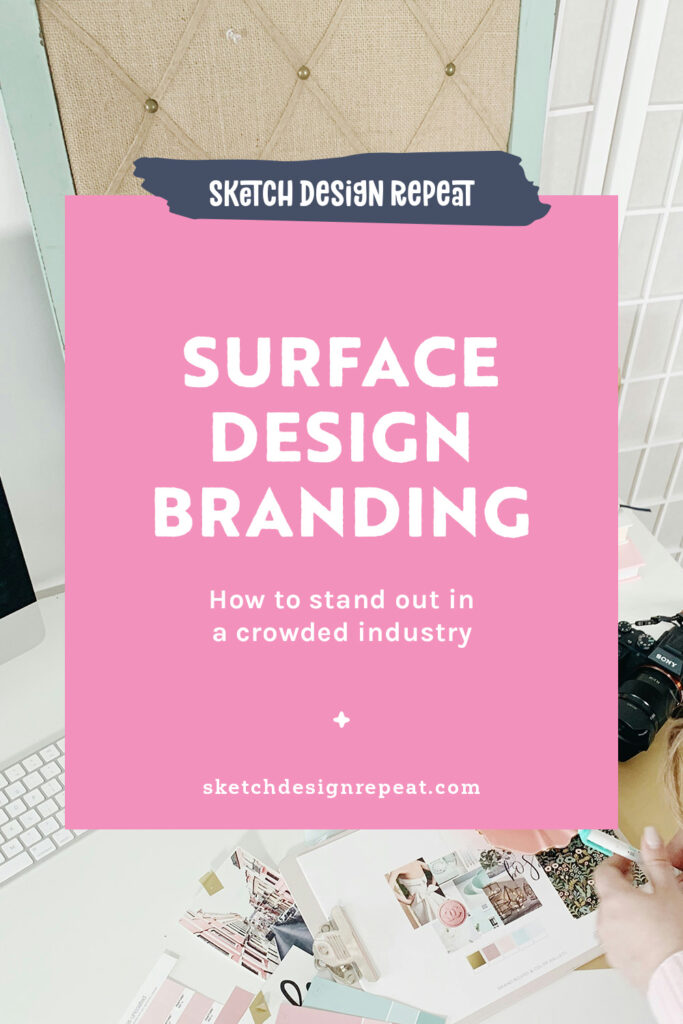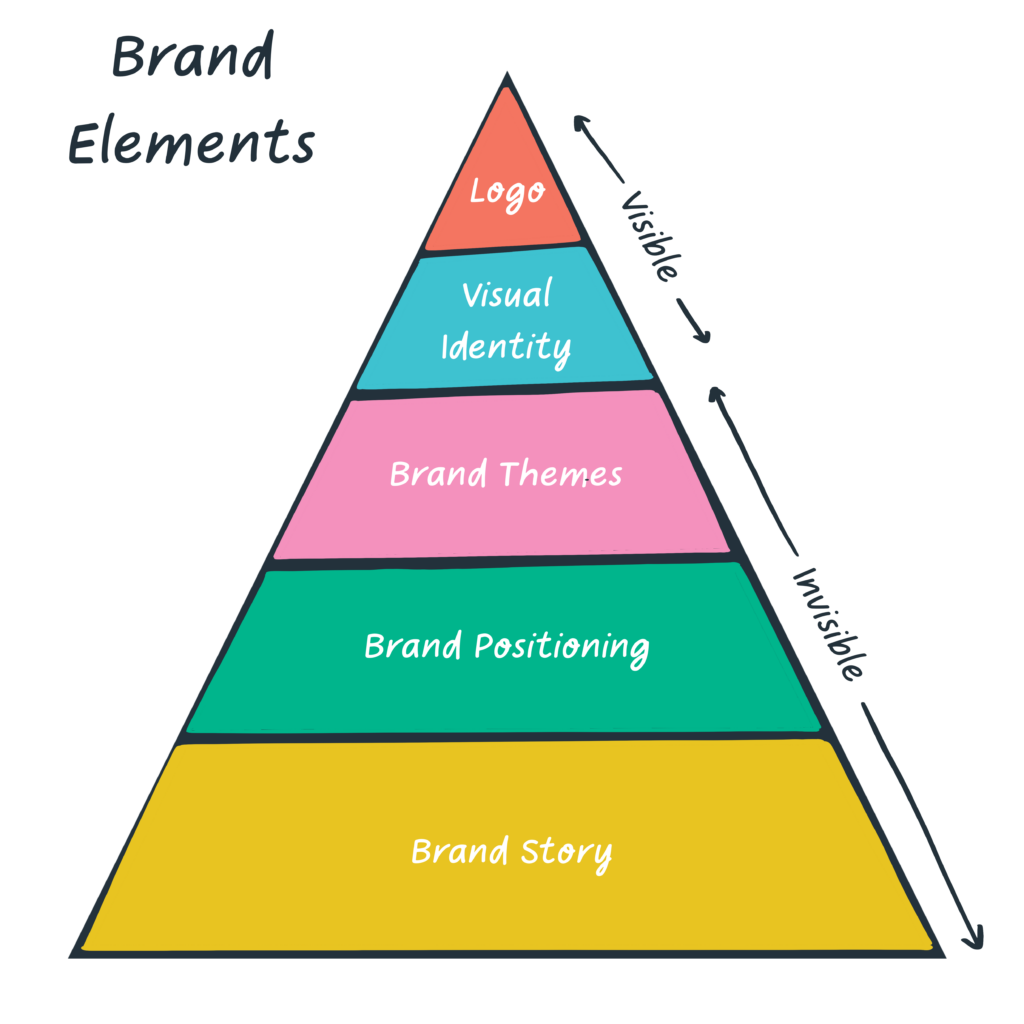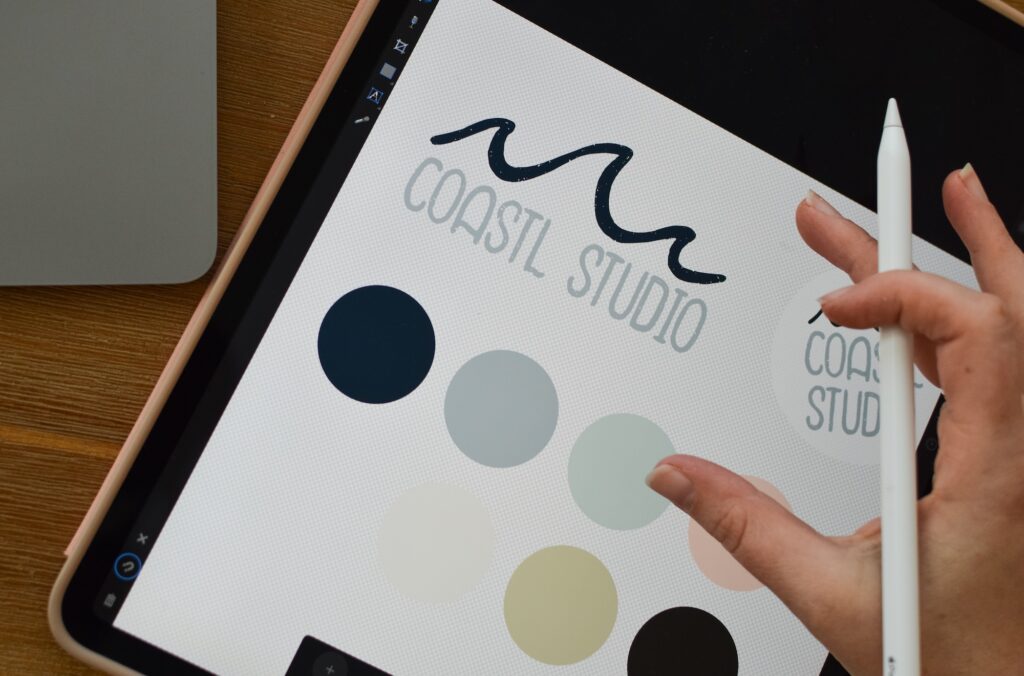If the first thing that comes to mind when you think of “brand” is a logo, you’re not alone. When you think of Nike’s brand, you think of the swoosh, or you associate the iconic golden arches with McDonalds. But a brand is much more than a logo, and what’s under the surface is as (if not more) important to helping you stand out, especially in a crowded industry.

There’s a lot of amazing artists in the surface pattern design community, and standing out is incredibly important (especially if you don’t already have thousands of followers on social media). Crafting a brand behind your work makes it easier for your work to resonate with buyers and can help you sell more if you’re sharing your work on products.
So what is a brand, if not a logo? Your brand consists of several parts. If you think of your branding as a pyramid, the base of your brand is your brand story, brand’s positioning, brand themes, and a wider visual identity building on top of it.

Brand Story
Telling the story of how and why your brand came to be helps customers connect to your business in an emotional way. Your brand story can also create a point of differentiation from other artists by highlighting your unique journey and how it helped shape your style and business.
For example, my brand story for CoastL Studio is that I always loved the beach but never lived nearby, so I wanted to bring coastal living to my home to add a little vacation to everyday! Think about your own story — what’s your why? And how does it inspire emotion in others?
The most important thing to note about your brand story is that it needs to be authentic, but can also be romanticized. Instead of “I wanted to make enough money with my art to quit my 9 to 5” maybe you frame it as “I started my business so I could spend my time creating art inspired by my favorite place, the beach.” Only you can write your brand story, but it’s always a good idea to bounce ideas off business friends!
Brand Positioning
Brand positioning is the process of connecting your brand to the lives of your customers. Starting with your brand story, you’ll need to demonstrate to your customers what makes your art special to them, beginning with defining your style and the added value of your art (like key motifs or messages) and your target audience and industry.
Once you have identified your target audience (more on that here), you can connect your art style and value to their lives! Defining your target audience and industries doesn’t mean you can’t license elsewhere, but it gives a focus to your communications and pitching.
Related Article: Personal Branding Photography for Creatives
Brand Themes
Speaking of communications, your brand themes are another key piece of your brand that no one sees, but everyone feels. Your brand themes (or pillars) create a connection and relationship with your audience by drawing parallels from your brand to other ideas or topics. Based on your brand positioning, you can choose brand themes that will help you generate topics for marketing content to connect your target audience with your art.
Think of your brand like it was a magazine for your target audience — what sections would you highlight? A few examples: home decor inspiration, gift ideas for relevant occasions (especially if you’re targeting the card market!), self-care, sewing content (for fabric designers), or nature.
You can have as many or as few pillars as you want, but I’ve found that at least five makes it easy to ensure you’ve got plenty of ideas to cover social media posts, blog posts, or any other content you’re creating.

Visual Identity
Finally, your brand’s visual identity goes beyond a logo. It should also include secondary marks, fonts, a color palette, and even a few signature patterns. Having a consistent visual identity will help you become more recognizable over time and will demonstrate a higher level of professionalism!
Logo and Secondary Marks
I’m a firm believer that you don’t need a logo to get started, but you do want to have one as you grow your business. Your logo can be as simple as your name in a unique font, or as intricate as you’d like. Along with your main logo, you may want secondary marks like a one-color version or a stacked version of a rectangular logo that fits into a square format.
Fonts
Generally, brands have 2–3 fonts: a primary font and 1–2 secondary fonts. These secondary fonts are the ones you use on your website and text in marketing materials. I recommend that your secondary fonts be easy to read and accessible on any platform (Canva, PowerPoint, etc.) that you’re using to make marketing materials.
If you’re looking for a unique font to use for a logo or as your primary font for headers and titles, Creative Market is a great place to start!
Color Palette
A core color palette will create a cohesive look and feel to your brand that you can apply to your website (as I mentioned in another post), print materials, and within your portfolio. You can use more than those colors in your art, but featuring work in the signature palette will reinforce your brand identity!
Signature Patterns
Speaking of art, featuring a few of your strongest patterns (in your core color palette) also creates consistency. And as an added bonus, having a few signature patterns helps prevent decision fatigue and makes it easier to create blog graphics and marketing materials!
All of these things come together to make your brand, and applying them consistently will help you stand out as a professional. When your brand demonstrates the value you and your art can bring, it also makes conversations and content feel less “salesy” and sound more like “let me help you.”
To help you keep your brand consistent, I created a brand template that you can fill out and keep in your workspace! Head over to LeahKeggi.com/brand-template for a few additional resources and to download the template.

Written by Leah Keggi
Website: www.LeahKeggi.com
Instagram: @coastlstudio
Class: Surface Design Marketing: Creating Content to Grow Your Business
Leah Keggi is a Marketing Pro and Pattern Designer looking to bring a little vacation into every day with coastal inspired design! Her work has been featured on Today.com and on products at Target.com. When she’s not designing (or working in Marketing) you can find her reading, enjoying her husband’s cooking, or walking her pup!